Fauna of Scotland
| Part of a series on the |
| Biodiversity of Scotland |
|---|
 |
The fauna of Scotland is generally typical of the northwest
Many populations of
Scotland's seas are among the most biologically productive in the world; it is estimated that the total number of Scottish marine species exceeds 40,000.[9] The Darwin Mounds are an important area of deep sea cold water coral reefs discovered in 1998. Inland, nearly 400 genetically distinct populations of Atlantic salmon live in Scottish rivers.[10] Of the 42 species of fish found in the country's fresh waters, half have arrived by natural colonisation and half by human introduction.
Only six amphibians and four land reptiles are
Habitats
Under the auspices of the European Union's Habitats Directive, 244 sites in Scotland covering more than 8,750 square kilometres (3,380 sq mi) had been accepted by European Commission as Special Areas of Conservation (SAC).[18][19] Scotland's seas are among the most biologically productive in the world and contain 40,000 or more species. Twenty-four of the SACs are marine sites, and a further nine are coastal with marine and non-marine elements.[20] These marine elements extend to an area of around 350 square kilometres (140 sq mi). The Darwin Mounds, covering about 100 square kilometres (39 sq mi), are being considered as the first offshore SAC.[19][21]
Mammals
Scotland was entirely covered in ice during the
Carnivores

The representation of the weasel family (
Other than occasional
Rodents, insectivores and lagomorphs

Seventy-five per cent of the UK's
Mainland
Of the lagomorphs only hares and rabbits are represented in Scotland. The mountain hare is the only native member of the hare family and is the dominant species throughout most of upland Scotland. The European hare and European rabbit are both present, the latter having been brought to Britain by the Romans[46] but not becoming widespread in Scotland until the 19th century.[47]
Artiodactyls
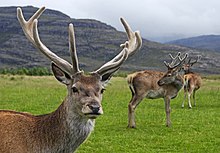
Other mammals
Only nine of the sixteen or seventeen bat species found elsewhere in Britain are present in Scotland. Widespread species are
Twenty-one species of
Extinctions and reintroductions
During the
A joint project of the
By means of escapes or deliberate releases, wild boar (Sus scrofa) have been re-introduced to several places in Scotland including a wide area of Lochaber and West Inverness-shire. Various other schemes are under consideration. For example, the owner of the Alladale estate north of Inverness has expressed a desire to reintroduce wolves as part of a wilderness reserve, the first of its kind in Britain.[53]
Avifauna
The history of mammals suggests three broad overlapping phases: natural colonisation after the ice age, human-caused extinctions, and introduction by humans of non-native species.
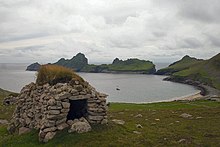
Most of about 250 species of bird regularly recorded in Britain venture into Scotland, and perhaps up to 300 more occur with varying degrees of rarity. A total of 247 species have been assessed and each placed onto one of three lists, red, amber or green, indicating the level of concern for their future. Forty species are red-listed, 121 are amber-listed and 86 are green-listed.[78][79]
The
Raptors
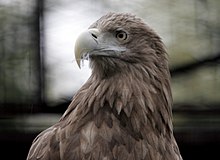
All but a few pairs of Britain's approximately 600 golden eagles are found in Scotland as are most of the breeding peregrine falcons.[83] The hobby, marsh harrier and Montagu's harrier although found in England and Wales are generally absent.[84]
In 1916 an English
After an absence of nearly 40 years the
Other raptor species found in the UK such as the kestrel, hen harrier, goshawk, sparrowhawk, tawny owl, and barn owl are widely distributed in Scotland, although the little owl is confined to the south.[91][92] Buzzards have displayed a remarkable resilience, having recovered from human persecution and the myxomatosis epidemic of the 1950s, which reduced their food supply. Numbers more than trebled between 1978 and 1998.[93] At the other end of the population scale, a single pair of snowy owls bred on Fetlar from 1967 to 1975.[85]
In 2009 it was reported that the Scottish Government have decided to proceed with a controversial plan to relocate sparrowhawks found near pigeon lofts in Glasgow, Edinburgh, Kilmarnock, Stirling and Dumfries at a cost of £25,000.[94]
Seabirds

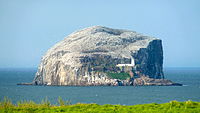
Scotland's seas host almost half of the
Sixty per cent of all breeding
In excess of 130,000 birds inhabit Fowlsheugh nature reserve in Aberdeenshire at the peak of the breeding season, making it one of the largest seabird colonies in Britain. There are significant numbers of kittiwake, Atlantic puffin, razorbill, fulmar, herring gull and great black-backed gull.[100] The Bass Rock in the Firth of Forth hosts upwards of 40,000 pairs of northern gannets and is the largest single rock gannetry in the world. The bird's scientific name Morus bassanus, derives from the rock.[101][102]
Game birds, waders and water fowl
Red-listed western capercaillie and ptarmigan breed in Scotland and are absent elsewhere in the British Isles. The former became extinct in Scotland in 1785 but was successfully reintroduced from Swedish stock in 1837.[103][104] There are significant populations of other Galliformes including blackcock and the famous red grouse.[105] Common quail, grey partridge and pheasant are well-distributed, although the red-legged partridge is less so.[106] A small colony of the introduced golden pheasant exists in the southwest.[107]
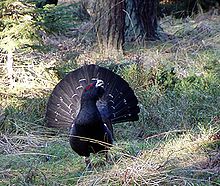
Among the waders,
About half of the 80,000
Other non-passerines
Considerable efforts have been taken to conserve the shy
Passerines
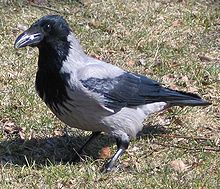
Ravens are typically forest-dwelling birds in much of Europe, but in Scotland they are generally associated with mountains and sea coasts. In 2002 the hooded crow was recognised as a separate species[116] from the carrion crow. Scotland and Northern Ireland host all of the approximately 190,000 UK territories of the former.[117] A recent survey suggest that raven numbers are increasing but that hooded crows had declined by 59% while carrion crow numbers were essentially static.[118] Concentrated on the islands of Islay and Colonsay, about 80 of Britain's 400 pairs of red-billed chough nest in Scotland.
In addition to
Vagrants
Scotland's position on the western seaboard of Europe means that a variety of birds not normally found in the country visit from time to time. These include accidental visits by vagrant birds that have wandered far from their normal habitations.
Elsewhere, other rarities reported in 2006 include a
Extinctions
The
Fish life in the sea
Of the 42 species of fish found in Scottish fresh waters, only half have arrived by natural colonisation. Native species include
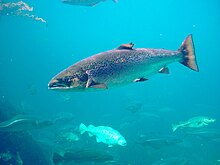
The freshwater pearl mussel was once abundant enough to support commercial activities,[129] and Scotland is the remaining European stronghold with about half the global number present. There are populations in more than 50 rivers, mainly in the Highlands, although illegal harvesting has seriously affected their survival.[130][131]
Scotland's seas, which constitute an area greater than that of the seas around the rest of the UK, are among the most biologically productive in the world. They are home to a third of the world's whale and dolphin species, most of the UK's
The
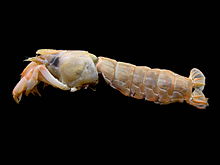
Further action on a much wider scale may be required. According to a recent report "Scotland's marine life could be almost wiped out within 50 years unless tough action is taken to manage the way humans use the seas". Fears were expressed by a consortium of environmental organisations that commercial fish stocks, including
Riverine extinctions
Pollution and predation led to the extinction of both species of vendace from its very restricted range in south-western Scottish freshwaters in 1980. In the 1990s a successful attempt to reintroduce Coregonus vandesius to the Lochmaben area began. Coregonus albula remains absent.[139][140][141][142]
Amphibians and land reptiles
Only six amphibians and four land reptiles are
The reptiles include the
Terrestrial invertebrates
Seventy-seven species of land snail[148] and an estimated 14,000 species of insect live in Scotland, none of them "truly" endemic.[149] These include Pardosa lugubris, a species of wolf spider first found in the UK in 2000 at Abernethy Forest nature reserve, and the Scottish wood ant. These ants, which are the most numerous residents of the Caledonian pine forest, build mounds from the pine cones and needles they find on the forest floor and may inhabit the mounds for decades. A single colony may collect 100,000 insects a day to feed its half million citizens and produce up to 250 kilograms (550 lb) of honeydew per season.[150]
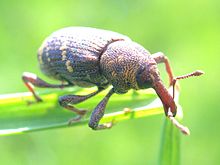
In addition to the Scottish wood ant, several Scottish species of invertebrate exist that are otherwise rare in the UK and important enough to have a specific "Action Plan" to provide protection. These are five species of
Although many species of butterfly are in decline in the UK, recent research suggests that some, such as the pearl-bordered fritillary, marsh fritillary and chequered skipper, which are becoming rare in the rest of the UK, are moving north into Scotland in response to climate change.[159][160] In June 2008 an adult Ethmia pyrausta moth was discovered in Easter Ross. This find was only the fifth sighting since its discovery in the UK at Loch Shin in 1853, and the species has gained "almost mythical status" according to Butterfly Conservation Scotland.[161]
The most well-known invertebrate may be a species of midge (
The islands of
Cryptozoology

A variety of exotic
Nature conservation in Scotland
Challenges
Conservation of the natural environment is well-developed in the
246 Martens, 198 Wild Cats, 106 Polecats, 67 Badgers, 58 Otters, 475 Ravens, 462 Kestrels, 371 Rough-legged Buzzards, 285 Common Buzzards, 275 Kites, 98 Peregrine Falcons, 92 Hen Harriers, 78 Merlins, 71 Short-eared Owls, 63 Goshawks, 35 Long-eared Owls, 27 Sea Eagles, 18 Ospreys, 15 Golden Eagles, 11 Hobbys, 6 Gyrfalcons, 5 Marsh Harriers, 3 Honey Buzzards,
and for reasons apparently unconnected to grouse shooting, a further
11 Foxes, 301 Stoats and Weasels, 78 House Cats, 1,431 Hooded or Carrion Crow, 3 Barn Owls, 8 Magpies and 7 "Orange-legged Falcons".
Writing in 1947, Perry stated that his "first reaction to this dreadful black-list was that of amazed incredulity. I still find the details incredible. However, they were supplied by the lessee himself."[171] In several instances these extermination totals are larger than the current resident numbers for the entire country.
It remains to be seen if the destruction wrought by the Victorians continues to be the nadir for the fauna of Scotland. In addition to other difficulties the marine environment faces,
The complexities involved in conserving Scottish wildlife are highlighted in an RSPB report, noting that pine martens have been found to be a significant predator of capercaillie nests. Both species are protected, providing conservation agencies with a challenging conundrum to address.[175] In 2012 the Scottish Government published a "Code of Practice on Non-Native Species" to help people understand their responsibilities and provide guidance as to which public body has responsibility for the various habitats involved.[176]
Conservation organisations
Various public sector organisations have an important role in the stewardship of the country's fauna.
The country has two
Charitable and voluntary organisations also have important roles to play. The
See also
- British avifauna
- Climate of Scotland
- Flora of Scotland
- Geography of Scotland
- Geology of Scotland
- Nature of the Outer Hebrides
- List of British amphibians
- List of British birds
- List of British butterflies
- List of British mammals
- List of British reptiles
- List of extinct animals of Britain
- List of fauna of the Scottish Highlands
- Lists of insects recorded in Britain
- List of moths of Great Britain (Arctiidae)
- List of moths of Great Britain (Geometridae)
- National nature reserve (Scotland)
- Royal Society for the Protection of Birds reserves in Scotland
References
- ^ a b Thompson, P.M.; Corkrey, R.; Lusseau, D.; Lusseau, S.M.; Quick, N.; Durban, J.W.; Parsons, K.M.; Hammond, P.S. (2006). "An assessment of the current condition of the Moray Firth bottlenose dolphin population". Scottish Natural Heritage Commissioned Report (175). Perth.
- ^ Matthews (1968) p. 254.
- ^ a b "Mammals". Scottish Natural Heritage. Archived from the original on 30 December 2006. Retrieved 1 January 2007.
- ^ Fraser Darling and Boyd (1969) pp. 7, 98–102.
- ^ Benvie (1994) p. 12.
- ^ In the past, this claim has been made on behalf of other species such as the red grouse (now considered to be a sub-species of willow ptarmigan) and Irish stoat (Mustela erminea hibernica), also now considered to be a sub-species of stoat. Loxia scotica's position as a true species is a matter of debate but the current consensus is that it does have this status (see for example Miles and Jackman (1991) pp. 21–30 and Benvie (2004) p. 55.) The position of the freshwater fish the vendace Coregonus vandesius is disputed, with many authorities considering it to be a synonym of Coregonus albula.
- ^ Adams, William Mark (2003) Future Nature. British Association of Nature Conservationists p. 30. Retrieved 14 July 2009. This source lists the UK's endemic species as being "14 lichens, 14 bryophytes, 1 fern, 21 higher plants, 16 invertebrates and 1 vertebrate (the Scottish crossbill)."
- ^ Perhaps because endemic vertebrates are all but absent from the UK neither SNH nor JNCC appear to provide a definitive "list" but it is clear that the Scottish crossbill is the only endemic bird, (Gooders (1994) p. 273. and "Scottish Crossbill: Loxia Scotica" (pdf) JNCC. Retrieved 7 July 2009.) and that there are no endemic freshwater fish (Maitland, P. and Lyle A.A. (1996) "Threatened freshwater fishes of Great Britain" in Kirchofer, A. and Hefti, D. (1996) Conservation of Endangered Freshwater Fish in Europe. Basel. Birkhauser.) or mammals ("The British Mammals list" Archived 28 July 2011 at the Wayback Machine ppne.co.uk. Retrieved 7 July 2009.) in Britain. There are too few amphibians and reptiles native to the UK for there to be any doubt that no endemic species exist. The position is implied, although not stated by SNH in their Information and Advisory Note Number 49 "Priority species in Scotland: animals" Archived 9 November 2016 at the Wayback Machine Retrieved 7 July 2009. See also Myers, Norman (2003) "Conservation of Biodiversity: How are We Doing?" Archived 16 July 2011 at the Wayback Machine (pdf) The Environmentalist 23 pp. 9–15. Retrieved 7 July 2009. This publication confirms there is only one "endemic non-fish vertebrate species" in the British Isles, although it fails to identify the species concerned.
- ^ a b "Inshore Fisheries in Scotland". The Scottish Government. Archived from the original on 7 June 2011. Retrieved 24 August 2008.
- ^ a b "Protecting and Promoting Scotland's Freshwater Fish and Fisheries". Scottish Executive. Archived from the original on 29 August 2009. Retrieved 13 January 2007.
- ^ Miles and Jackman (1991) p. 48.
- ^ See for example Johnston, I. (29 November 2006) "Sea change as plankton head north'". Edinburgh. The Scotsman. This report quotes James Lovelock's concern that global warming will "kill billions" of people over the coming century.
- ^ a b "Scottish wildlife habitats". Scottish Natural Heritage. Archived from the original on 22 December 2006. Retrieved 2 January 2007.
- ^ Although no one denies that past forests were much larger, they disagree about the timing and causes of the reduction. Many writers, from the 16th century author Hector Boece to the 20th century naturalist Frank Fraser Darling, believed that the woods were much more extensive in Roman times than today. However, it is now thought that deforestation of the Southern Uplands, caused by climate and by people, was well underway when the legions arrived. See Smout (2007) pp. 20–32.
- ISBN 0-19-851067-5.
- ^ Ratcliffe, D.A. (7 October 1998). Flow Country: The peatlands of Caithness and Sutherland (Report). Joint Nature Conservation Committee.
- ^ "North Highland: Peatlands of Caithness & Sutherland". Scottish Natural Heritage. Archived from the original on 28 November 2005. Retrieved 2 January 2007.
- ^ "SACs in Scotland" Joint Nature Conservation Committee. Retrieved 29 September 2018.
- ^ a b c "Trends: The Seas around Scotland". Scottish Natural Heritage. Archived from the original on 4 August 2004. Retrieved 19 January 2007. Quoting the Scottish Office. (1998). People and nature. A new approach to SSSI designations in Scotland. The Scottish Office, Edinburgh. Retrieved 2 January 2007.
- ^ a b c "Knowledge of the Marine Environment" (PDF). Scottish Natural Heritage. Archived from the original (PDF) on 9 July 2007. Retrieved 1 August 2007.
- ^ "Offshore" in this context means not incorporating any land.
- ^ Save for the Atlantic outlier of St Kilda. Maclean (1972) p. 20.
- ^ Murray (1973) p. 72.
- ^ a b "National Heritage Trends" (PDF). Scottish Natural Heritage. Archived from the original (PDF) on 15 December 2007. Retrieved 1 January 2007.
- ^ Benvie (2004) p. 645.
- ^ "Orkney vole" (PDF). Scottish Natural Heritage. Archived from the original (PDF) on 26 October 2007. Retrieved 1 January 2007.
- ^ Corbet and Ovenden (1984) pp. 180–86.
- ^ Benvie (2004) p. 48.
- ^ "Scotland's Cat; 400 and counting ..." Scottish Wildcat Association. Archived from the original on 17 September 2012. Retrieved 1 January 2007.
- ^ Matthews (1968) pp. 231–32.
- ^ Benvie (2004) p. 18.
- ^ Hull (2007) pp. 184–89.
- ^ "Remote island plan to help save Scottish wildcats from extinction". (23 September 2013) Glasgow. The Herald. Retrieved 25 September 2013.
- ^ Haworth, Jenny (3 February 2009) "National cull may exterminate UK mink". Edinburgh. The Scotsman.
- ^ Ross, John (12 May 2011) "Wildlife Groups agree £1m plan to wipe out American mink nuisance". Edinburgh. The Scotsman.
- ^ "Seals" (PDF). Scottish Natural Heritage. Archived from the original (PDF) on 13 December 2007. Retrieved 1 January 2007.
- ^ "Red Squirrels". Scottish Natural Heritage. Archived from the original on 20 April 2004. Retrieved 1 January 2007.
- ^ The Scottish Wildlife Trust have announced a four-year project to commence in the spring of 2009 called "Saving Scotland's Red Squirrels". See "A new era for Scotland's red squirrels?" in Scottish Wildlife (November 2008) No. 66. Edinburgh.
- ^ Watson, Jeremy (30 December 2007) "Tufty's saviour to the rescue". Scotland on Sunday. Edinburgh. It is theorised that because grey squirrels spend more time on the ground than the endangered reds, they are more apt to come in contact with this predator.
- ^ Corbet and Ovenden (1984) pp. 152, 167–68.
- ^ "Developing a mammal monitoring programme for the UK" (PDF). Joint Nature Conservation Committee. Archived from the original (PDF) on 4 September 2012. Retrieved 2 January 2007.
- ^ "Uist Wader Project Newsletter" (PDF). Scottish Natural Heritage. August 2004. Archived from the original (PDF) on 22 September 2006. Retrieved 1 January 2007.
- ^ "Campaign to stop the slaughter of over 5000 Hedgehogs on the Island of Uist". Epping Forest Hedgehog Rescue. Archived from the original on 27 August 2006. Retrieved 1 January 2007.
- ^ Ross, John (21 February 2007). "Hedgehogs saved from the syringe as controversial Uist cull called off". The Scotsman. Edinburgh.
- ^ Ross, John (3 November 2007) "3,2,1 ... and then there were none". Edinburgh. The Scotsman.
- ^ "Rabbits". BBC Nature. Retrieved 1 January 2007.
- ^ a b c d e MacCormick, Finbar and Buckland, Paul C. The Vertebrate Fauna in Edwards, Kevin J. & Ralston, Ian B.M. (Eds) (2003) Scotland After the Ice Age: Environment, Archaeology and History, 8000 BC – AD 1000. Edinburgh. Edinburgh University Press. pp. 83–103.
- ^ Bronkhurst, Judith and Ormond, Richard (2004–12) "Landseer, Sir Edwin Henry (1802–1873)". Oxford Dictionary of National Biography. Oxford University Press.
- ^ Benvie (2004) pp. 14, 44.
- ^ Quine (2000) pp. 30, 199.
- ^ Benvie (2004) p. 36.
- ^ Hull (2007 p. 268.
- ^ a b c d e Watson, Jeremy (12 October 2006). "Sea eagle spreads its wings ...". Scotland on Sunday. Edinburgh.
- ^ Racey, P.A.; Raynor, R.; Pritchard, S. (2006). "A review of European Bat Lyssavirus (EBLV) and the status of bats in Scotland". Scottish Natural Heritage Commissioned Report (63). Perth.
- ^ "Shetland Bat Records" Archived 22 November 2008 at the Wayback Machine Shetland Biological Records Centre. Retrieved 10 August 2008.
- ^ "Trends - The Sea" (PDF). Scottish Natural Heritage. Archived from the original (PDF) on 25 February 2012. Retrieved 1 January 2007.
- ^ "Adopt a Natural Born Killer". The International Harpoon. (1995) No. 1.
- ^ Benvie (2004) p. 112.
- ^ Edwards, Rob (18 November 2007) "Famous Moray dolphins at risk as Whitehall fails to block oil and gas works". Glasgow. Sunday Herald. A coalition of conservation groups including WWF, The Wildlife Trust, the Marine Conservation Society and the RSPB have written to the minister concerned "urging him to abandon the plans".
- ^ Haworth, Jenny (29 January 2009) "Campaigners win reprieve for dolphins". Edinburgh. The Scotsman.
- ^ a b c Welch, D.; Carss, D.N.; Gornall, J.; Manchester, S.J.; Marquiss, M.; Preston, C. D.; Telfer, M.G.; Arnold, H.R.; Holbrook, J. (2001). "An Audit of Alien Species in Scotland". Scottish Natural Heritage Review (139). Perth.
- ^ Murray (1973) pp. 55, 71.
- ^ Murray (1973) p. 114.
- ^ Hull (2007) p. 240.
- ^ "Extinct Island Pig Spotted Again". BBC News. 17 November 2006. Retrieved 1 January 2007.
- ^ a b Fraser Darling and Boyd (1969) p. 64
- ^ Although McCormick and Buckland (2003) state that a claim is made for the last wolf having been shot in Durness in 1749.
- ^ Corbet and Ovenden (1984) pp. 275–79.
- ^ Maclean (1972) pp. 21–22.
- ^ Fraser Darling and Boyd (1969) p. 63.
- ^ "Down to beaver business". (August 2008) Scottish Wildlife 65. pp. 26–27.
- ^ "Bringing back the Beaver". Royal Zoological Society of Scotland. Archived from the original on 29 January 2011. Retrieved 8 July 2008.
- ^ "Beavers return after 400-year gap". BBC News. 29 May 2009. Retrieved 15 June 2009.
- ^ "Plan to trap River Tay beavers reversed by ministers". BBC News. 16 March 2012. Retrieved 29 March 2018.
- ^ "Beaver population increased in Knapdale". Scottish Wildlife Trust. 28 November 2017. Retrieved 29 March 2018.
- ^ Gooders (1994) p. 35.
- ^ Peterson et al. (1993) Map 9.
- ^ "Populations Status of Birds in the UK". British Trust for Ornithology. Archived from the original on 6 December 2006. Retrieved 6 January 2007.
- ^ "Birds of conservation concern: 2002–2007" (PDF). RSPB. Retrieved 7 January 2007.
- ^ Benvie (2004) p. 55.
- ^ Miles and Jackman (1991) p. 21.
- ^ Maclean (1972) p. 21.
- ^ Brown (1989) pp. 175, 176, 187.
- ^ Gooders (1994) pp. 85, 86, 94.
- ^ a b McFarlan, D., ed. (1991). The Guinness Book of Records. Enfield: Guinness Publishing. p. 35.
- ^ Fraser Darling and Boyd (1969) p. 65 states that they bred until the 1960s.
- ^ "East Scotland Sea Eagles" Archived 4 January 2014 at the Wayback Machine. RSPB. Retrieved 30 April 2012.
- ^ Ross, John (29 December 2006). "Mass slaughter of the red kites". The Scotsman. Edinburgh.
- ^ Fraser Darling and Boyd (1969) p. 274.
- ^ Benvie (2004) p. 102.
- ^ Brown (1989) pp. 104, 115.
- ^ Gooders (1994) pp. 84, 88, 89, 92, 179–82.
- ^ Benvie (2004) p. 70.
- ^ Edwards, Rob (1 February 2009) "Bid to save pigeons from sparrowhawks provokes legal warning ... and complaint by Peacock". Glasgow. Sunday Herald.
- ^ "RSPB Scotland Parliamentary Briefing: Debate on Scotland's Marine Environment – 20th March 08". RSPB. Archived from the original (pdf) on 15 October 2012. Retrieved 24 August 2008.
- ^ Benvie (2004) pp. 116, 121, 132–34.
- ^ "Mingulay birds". National Trust for Scotland. Archived from the original on 2 October 2006. Retrieved 16 February 2007.
- ^ Benvie (2004) pp. 128–38.
- ^ Johnston, I. (6 January 2007). "Escalating threat to the future of Scotland's seas". The Scotsman. Edinburgh. The report quotes British Trust for Ornithology figures.
- ^ "Fowlsheugh Reserve". RSPB. Retrieved 29 September 2018.
- ^ "Gannet Morus bassanus [Linnaeus, 1758]". British Trust for Ornithology. Retrieved 24 August 2008.
- ^ "The Wildlife". Scottish Seabird Centre. Retrieved 13 January 2007.
- ^ "Species Profile: Capercaillie" Archived 18 April 2009 at the Wayback Machine Trees for Life. Retrieved 8 September 2008.
- ^ "Species Action Plan: Capercaillie (Tetrao urogallus)" Archived 27 October 2007 at the Wayback Machine UK Biodiversity Action Plan. Retrieved 8 September 2008.
- ^ Gooders (1994) pp. 98–101.
- ^ Gooders (1994) pp. 97, 102, 103, 106.
- ^ Gooders (1994) pp. 104–05.
- ^ Gooders (1994) pp. 113–44.
- ^ Peterson et al. (1993) Maps 152 and 157.
- ^ Perrot, D. et al. (1995) The Outer Hebrides Handbook and Guide. Machynlleth. Kittiwake. pp. 86–90.
- ^ Gooders (1994) p. 51.
- ^ "Basin Birds". Montrose Basin LNR. Archived from the original on 2 April 2012. Retrieved 1 April 2012.
- ^ "Black-throated Diver". RSPB. Retrieved 7 January 2007.
- ^ "Wryneck". RSPB. Retrieved 13 November 2016.
- ^ Gooders (1994) pp. 171, 175.
- ^ "Hooded Crow: Corvus cornix". C. Michael Hogan, GlobalTwitcher.com, ed, N. Stromberg. Archived from the original on 26 November 2010. Retrieved 20 September 2009.
- ^ "Hooded Crow". RSPB. Retrieved 7 January 2007.
- ^ "National Heritage Trends" (PDF). Scottish Natural Heritage. Archived from the original (PDF) on 19 October 2007. Retrieved 7 January 2007.
- ^ Benvie (2004) p. 79.
- ^ Ross, John (26 June 2007). "Habitat changes leave the twite living on a wing and prayer". The Scotsman. Edinburgh.
- ^ "Common and Rare Migrants". Fair Isle Bird Observatory. Archived from the original on 23 March 2007. Retrieved 4 January 2007.
- ^ Haswell-Smith (2004) p. 410.
- ^ British Birds (August 2006) 199. London: BB 2000.
- ^ Cook (1992) pp. 37, 39, 57.
- ^ Cook (1992) pp. 85, 41, 45, 80.
- ^ Haswell-Smith (2004) p. 325.
- ^ "The IUCN Red List of Threatened Species". IUCN Red List of Threatened Species. Retrieved 27 October 2018.
- ^ "Arctic Charr". Scottish Natural Heritage. Archived from the original on 19 March 2012. Retrieved 30 April 2012.
- ISBN 1-84158-199-2
- ^ "Invertebrate species: molluscs". Joint Nature Conservation Committee. Retrieved 13 January 2007.
- ^ "Police crack down on illegal 'ransacking' of mussel sites". The Herald. Glasgow. 26 May 2010.
- ^ "Turtles in Scotland" Archived 8 February 2007 at the Wayback Machine. North East Scotland Biodiversity. Retrieved 20 April 2012.
- ^ "Marine Scotland survey uncovers 'huge' flame shell bed". (27 December 2012) BBC. Retrieved 27 December 2012.
- ^ "Biogenic reefs - cold water corals". Joint Nature Conservation Committee. Retrieved 7 January 2007.
- ^ "Protection for Darwin Mounds". Scottish Executive. Archived from the original on 3 October 2012. Retrieved 8 January 2007.
- S2CID 53620435.
- ^ Johnston, I. (6 January 2007). "Escalating threat to the future of Scotland's seas". The Scotsman. Edinburgh.
- ^ Smith, S. 1998. Calyptraea chinensis (L., 1758) (Mollusca: Gastropoda). Newsletter PMNHS No. 1. p.10.
- ^ "Scotland's Biodiversity: It's in Your Hands - A strategy for the conservation and enhancement of biodiversity in Scotland" Archived 20 January 2012 at the Wayback Machine. The Scottish Government. Retrieved 10 August 2007.
- ^ "A Royal Fish" Archived 17 December 2008 at the Wayback Machine (pdf) SNH. Retrieved 10 August 2007.
- ^ "Ice Age fish thrives in new home" BBC. Retrieved 16 May 2008.
- ^ Winfield, Ian J., Fletcher, Janice M., and James, Ben (2004) "Conservation ecology of the vendace (Coregonus albula) in Bassenthwaite Lake and Derwent Water U.K." Ann. Zool. Fennici. 41 pp. 155–164.
- ^ "The IUCN Red List of Threatened Species". IUCN Red List of Threatened Species. Retrieved 27 October 2018.
- ^ "Publications: Amphibians & Reptiles". Scottish Natural Heritage. Archived from the original on 1 September 2009. Retrieved 10 August 2008.
- ^ Johnston, Ian (19 March 2007). "Scotland 'sliding towards the collapse of our ecosystem'". The Scotsman. Edinburgh. The article quotes Call 999: an Emergency for Scotland's Biodiversity. Summary and Assessment for Scotland from the UK Biodiversity Action Plan 2005 Reporting Round published by Scottish Environment Link also in March 2007.
- ^ "Protected species - Amphibians and reptiles" Archived 27 April 2012 at the Wayback Machine. SNH. Retrieved 20 April 2012.
- ^ "Reptiles". Thomson ecology. Archived from the original on 19 January 2011. Retrieved 13 January 2007.
- ^ Carter, Stephen P. "Land Snails" in Edwards and Ralston, Ian (2003) p. 104.
- ^ a b Buckland, Paul C. and Sadler, Jon P. "Insects" in Edwards and Ralston (2003) pp. 105–08.
- ^ Miles & Jackman (1991) p. 47.
- ^ "Invertebrates". Scottish Natural Heritage. Archived from the original on 31 December 2006. Retrieved 15 January 2007.
- ^ Ross, David (13 September 2007 ) "Rare species of burrowing bee has flourished in Outer Hebrides". Glasgow. The Herald.
- ^ "The bee's knees". (Spring 2007) Broadleaf No. 68. Grantham. Woodland Trust.
- ^ "World's first bumblebee sanctuary created in Scotland." Archived 6 November 2009 at the Wayback Machine Wildlife Extra. Retrieved 29 July 2008.
- ^ Thompson (1968) p. 21
- ^ Ross, John (16 July 2010) "Beetle mania as 'extinct' insect found on Scots isle". Edinburgh. The Scotsman. Retrieved 19 July 2010.
- ^ Northern February red status "Northern February red stonefly". Buglife. Retrieved 10 June 2012.
- ^ "Poor Planning Threatens Northern Damselfly" Archived 3 April 2012 at the Wayback Machine. Badenoch and Strathspey Conservation Group. Retrieved 10 June 2012.
- ^ Smith, Claire (21 July 2007) "Butterflies are flitting here from the South." Edinburgh. The Scotsman.
- ^ "The state of Britain's butterflies 2007" (pdf) Butterfly Conservation. Retrieved 21 July 2007.
- ^ Davies, Eilidh (3 June 2008) "Rare moth rescued from becoming a spider's next meal". Aberdeen. Press and Journal.
- ^ "Highland biting midge". Trees for Life. Archived from the original on 31 May 2009. Retrieved 15 January 2007.
- ^ According to Miles & Jackman (1991) p. 48 the 'timberman' is found only in Scotland.
- ^ "Colonsay and Oronsay to become honeybee havens". Edinburgh. Scotland on Sunday. Retrieved 7 October 2013.
- ^ "The Scottish Wildcat". The Scottish Big Cat Trust. Retrieved 10 August 2007.
- ^ "The Beast of Buchan". The Scotsman. 24 December 2006. Retrieved 1 January 2007.
- ISBN 0-224-03961-X.
- ^ "Kellas Cat (Melanistic hybrid)". Paws On-Line. Archived from the original on 21 August 2009. Retrieved 10 August 2007.
- ^ Adomnán. "The Life of Columba". University College Cork. Retrieved 25 June 2007.
- ^ Simpson, Yvonne A. "The Strange Case of the Stronsay Beast" Archived 14 September 2008 at the Wayback Machine theangloscot.co.uk. Retrieved 10 August 2008.
- ^ Perry (1948) pp. 54–55.
- ^ Benvie (2004) pp. 19, 30, 34.
- ^ Johnston, I. (19 November 2006). "Sea change as plankton head north". The Scotsman. Edinburgh.
- ^ Hardie, Alison (20 January 2007). "Dramatic decline in island common seal populations baffles experts". The Scotsman. Edinburgh.
- ^ "The capercaillie conundrum" (October 2007) BBC Wildlife 25 No. 9.
- ^ "Code of Practice on Non-Native Species" Scottish Government. Retrieved 9 July 2012.
- ^ "SNH Annual Review 2006" (PDF). Scottish Natural Heritage. Archived from the original (PDF) on 16 March 2007. Retrieved 16 February 2007.
- ^ A new policy for NNRs was developed in 1996, which required them to have four attributes: primacy of nature, national importance, best practice management and continuity of management. The sites not meeting these characteristics were removed from the list. See "The Story of Hermaness National Nature Reserve: Appendix 1". SNH.
- ^ "About NNRs". Scotland's National Nature Reserves. Retrieved 29 September 2018.
- ^ "The Park". Cairngorms National Park Authority. Retrieved 30 April 2012.
- ^ "Welcome to the John Muir Trust" John Muir Trust. Retrieved 3 January 2007.
- ^ "Our Vision". Trees for Life. Archived from the original on 14 March 2012. Retrieved 3 January 2007.
Cited texts
- Benvie, Neil (2004) Scotland's Wildlife. London. Aurum Press. ISBN 1-85410-978-2
- Brown, Leslie (1989) British Birds of Prey. London. Bloomsbury. ISBN 1-870630-63-7
- Corbet, Gordon and Ovenden, Denys (1984) The Mammals of Britain and Europe. Glasgow. Collins. ISBN 0-00-219774-X
- Cook, Martin (1992). The Birds of Moray and Nairn. Edinburgh: Mercat Press. ISBN 1-873644-05-1
- Edwards, Kevin J. & Ralston, Ian B.M. (Eds) (2003) Scotland After the Ice Age: Environment, Archaeology and History, 8000 BC - AD 1000. Edinburgh. Edinburgh University Press. ISBN 0-7486-1736-1
- Fraser Darling, F. & Boyd, J.M. (1969) Natural History in the Highlands and Islands. London. Bloomsbury. ISBN 1-870630-98-X
- Gooders, J. (1994) Field Guide to the Birds of Britain and Ireland. London. Kingfisher. ISBN 0-86272-139-3
- Haswell-Smith, Hamish (2004) The Scottish Islands. Edinburgh. Canongate. ISBN 978-0-86241-579-2
- Hull, Robin (2007) Scottish Mammals. Edinburgh. Birlinn. ISBN 1-84158-536-X
- MacLean, Charles (1972) Island on the Edge of the World: the Story of St. Kilda. Edinburgh. Canongate. ISBN 0-903937-41-7
- Matthews, L. Harrison (1968) British Mammals. London. Bloomsbury. ISBN 1-870630-68-8
- Miles, H. and Jackman, B. (1991) The Great Wood of Caledon. Lanark. Colin Baxter Photography. ISBN 0-948661-26-7
- Murray, W. H.(1973) The Islands of Western Scotland: the Inner and Outer Hebrides. London. Eyre Methuen. SBN 413303802
- Perry, Richard (1948). In The High Grampians. London. Lindsay Drummond. OCLC 11102623
- Peterson, Roger Tory; Mountfort, Guy; and Hollom, P.A.D. (1993) Birds of Britain and Europe. Glasgow. HarperCollins. ISBN 978-0-00-219900-1
- Quine, David (2000). St Kilda. Grantown-on-Spey. Colin Baxter Island Guides. ISBN 1-84107-008-4
- Smout, T.C. MacDonald, R. and Watson, Fiona (2007) A History of the Native Woodlands of Scotland 1500–1920. ISBN 978-0-7486-3294-7
- Thompson, Francis (1968) Harris and Lewis, Outer Hebrides. Newton Abbot. David & Charles. ISBN 0-7153-4260-6
- "Species lists". RSPB. Retrieved 9 January 2007.
External links
- Scottish Natural Heritage
- Forestry Commission Scotland Archived 17 December 2010 at the Wayback Machine
- Joint Nature Conservation Committee
- Scottish Wildlife Trust
- Royal Zoological Society of Scotland
- Scotland's National Nature Reserves
- Royal Society for the Protection of Birds
- Scottish Seabird Centre
- Cairngorms National Park Authority
- Loch Lomond & The Trossachs National Park Authority
- John Muir Trust
- Trees for Life
- Butterfly Conservation Scotland
- Introduction To Britain's Lost Wildwood
- Scottish Wildcat Association Archived 17 September 2012 at the Wayback Machine
